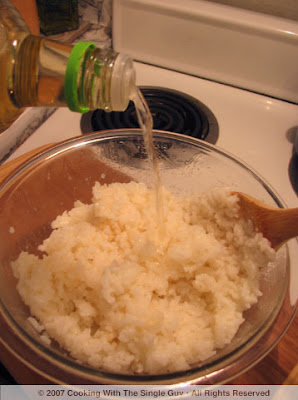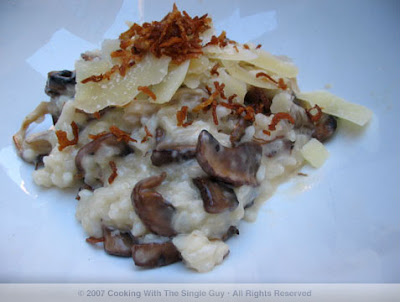 Tokyo Pop Ramen in the Richmond
Tokyo Pop Ramen in the Richmond 3944 Geary Blvd., San Francisco
Richmond District (between 3rd and 4th Avenues.)
Hours: Daily, 11:30 a.m. to 11 p.m.
PH: 415.752.2663
Major credit cards accepted
This new ramen place opened up on Geary Boulevard about two months ago and the folks on the Chowhound board have been raving about it. I love ramen, the Japanese soup noodles playfully highlighted in the Japanese movie Tampopo. (It’s a lot like saimin that I ate growing up in Hawaii but with better broth.) But traveling all the way to the Richmond from the East Bay seemed a long way to go for a bowl of noodles.
Luckily for me (in a warped way, I guess), my acne started taking over my life recently and my dermatologist is located on Geary Boulevard, just two blocks from Genki Ramen. So Genki has become my post-acne visit treat.
When you walk into Genki Ramen’s tiny restaurant, you feel like you’re in some bad scene from Lost In Translation. Flat screen TVs are mounted around the wall blaring Japanese videos, mostly of young girls singing. When I first visited, I found it charming when they showed some TV show about ramen. But on a second visit, I could barely take the screeching teen-age sounds of this Japanese pop singer on a video that seemed like she was in a bubble gum factory that exploded.

So that’s the ambiance. Beyond the audio-visual, the rest of the furnishings are sleek and modern, with a lot of dark wood. But really, I’m just here for the ramen.
Genki Ramen offers a variety of ramen specials, appetizers, and robatayaki (grilled meats and vegetables sold by the skewer). In my first visit, I was enticed by the unagi tempura because I love unagi and never had it deep-fried in tempura. Even though I’m not a big fan of deep-fried eating, I ordered that along with the special Crab Leg Ramen. (Genki Ramen has beautifully photographed dishes in its menu and I loved the redness of the crab legs in the dish I ordered.)

My unagi tempura was fresh and hot, but the batter didn’t seem to stay on to the unagi. Must be that delicious unique unagi barbeque sauce playing havoc on the tempura batter. While the unagi was tender and delicious, I just didn’t get the tempura batter surrounding it and it didn’t enhance the eating experience.
Then came my ramen with the crab legs on one side. Remember how I thought the photo was all lovely with the redness of the cooked crab legs? Well, my crab legs were covered in tempura batter so all I saw were these golden puffed fingers instead of red crab legs. What they basically did was deep-fry the crab legs in tempura batter.

OK, I know those of you who love tempura probably thinks this is a good idea, just like shrimp tempura. Problem is, with shrimp tempura you can bite right into the batter and eat the shrimp. With this crab leg tempura at Genki Ramen, you bit into the tempura and got crab legs with the shell still on! That’s way too much crack for my crunch. The crab legs weren’t all shell; it was cut in half before it was fried in tempura batter. But still, you couldn’t enjoy the tempura batter because you had to break away the shell to get to the crab meat.
As I worked my way through the hot batter and equally hot crab legs, I kept thinking to myself, “Why would anyone think tempura crab shells would be fun to cover in batter?” It was so much work that I nearly drowned myself in the bowl of ramen afterwards. But after several minutes of being the sous chef at my table, I was able to get a nice mound of crab meat that I ate with the ramen.
Now the ramen. It was great. Firm but soft, filling and enjoyable. The broth was tasty and warm, filling my stomach with comfort and joy. It made up for the morsels of crab I sweated to get out.
 Determined to get a real ramen experience, I came back a few weeks later with my nephew. We ordered a gyoza to start and he ordered the Chicken Karaaga Ramen. I should have stuck with something simple but got enticed again by the Spicy Mabo Tofu Ramen. I'd never had Mabo Tofu Ramen (although I love Mabo Tofu and make it often for myself at home) but my nephew says it's pretty common in Hawaii now. So I ordered it. At least it's not deep fried.
Determined to get a real ramen experience, I came back a few weeks later with my nephew. We ordered a gyoza to start and he ordered the Chicken Karaaga Ramen. I should have stuck with something simple but got enticed again by the Spicy Mabo Tofu Ramen. I'd never had Mabo Tofu Ramen (although I love Mabo Tofu and make it often for myself at home) but my nephew says it's pretty common in Hawaii now. So I ordered it. At least it's not deep fried.
The gyoza was nice and tasty with a nice crunchiness on one side. (It was a bit too shiny from residual oil, however, even though you don't feel the greasiness. You do see it.) My nephew said he enjoyed his Chicken Karaaga Ramen (kids love the fried chicken) but he thought the broth was on the bland side. I, however, loved my broth. My bowl came out in this wonderful layer of soft tofu and juicy meat. It was definitely a dish you had to eat with your spoon to uncover the ramen underneath, which had the same firm but soft consistency from before. Without having to work this time for my meal, I totally was enraptured by the tofu, ramen and broth.

At its core, Genki Ramen offers excellent ramen noodles in a young environment. I have reservations about its deep-frying techniques, but everything else is satisfying and worth the trip to Geary Boulevard.
Single guy rating: 2 stars (a fancy introduction to ramen)
Explanation of the single guy's rating system:
1 star = perfect for college students
2 stars = perfect for new diners
3 stars = perfect for foodies
4 stars = perfect for expense accounts
5 stars = perfect for any guy's dream dinner














































